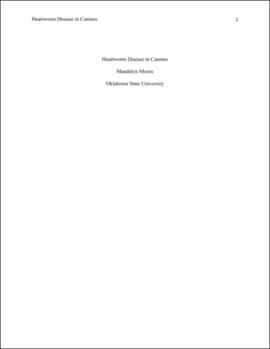| dc.description.abstract | Heartworm disease in canines is a complicated disease that has been diagnosed in all 50 states and in every continent excluding Antarctica. A filarial disease most commonly spread by D. immitis in North America, but also spread by other strains such as D. repens in other parts of the world. In North American infections are commonly seen in domestic and wild canids, but in many subtropical countries human infections have been diagnosed. Human infections manifest in one of four ways, pulmonary, subcutaneous, ocular, and lymphatic. Each different manifestation is accompanied by different symptoms and prognoses. Many infected dogs will be asymptomatic, but as the infection worsen and worm burden increases, dogs will show symptoms such as lethargy and decrease in exercise tolerance. As infection worsens, the symptoms will become more severe and eventually lead to right sided heart failure. Heartworm infections in canines can be diagnosed various ways depending on resources. The two most common methods of diagnosing a heartworm infection are ELISA antigen tests, many are commercially available to veterinarians, and blood smear tests to identify microfilaria. Melarsomine dihydrochloride injections have been the go to treatment for years, but due to its high cost and severe complications, many owners and veterinarians are turning to alternative treatments, such as Advantage Multi (10% imidacloprid + 2.5% moxidectin) + doxycline, as cheaper and safer treatment option. Prevention of heartworm disease is a cheaper and safer option than treatment. Many effective heartworm preventions are on the market. In areas of high infection rates and possibly resistant strains, owners and veterinarians are turning toward a double defense protocol, utilizing heartworm preventive as well as repellent to prevent the spread of heartworm disease. With education about prevention and the heartworm life cycle, clients would be more willing to comply with recommendations regarding heartworm preventatives. | |
